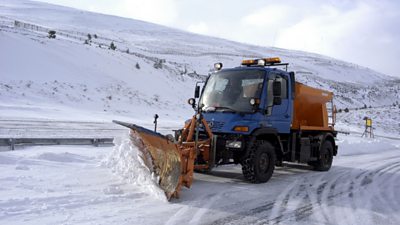General precautions
- Is the journey really necessary?
- Before travelling, check the planned route in relation to traffic warnings and weather forecasts - is it workable, is there enough time to complete the journey before conditions change or darkness falls? Most car radios have a 'traffic alert' (TA) option - use this if you have any concerns about the weather affecting your journey. Observe traffic warnings given by national and local radio stations, Highways Agency, and others.
- Weather forecasts for more than two days ahead can be unreliable, so monitor the weather right up until departure and be prepared to change your plans
- Communications - if you get into difficulties, will you be able to ask for help? Keep mobile phones fully charged. If remote, consider need for satellite phones or personal locator beacons (PLBs)
- If you do get stuck, you are unlikely to be the only one, so make sure you have plenty of fuel (top up regularly if poor weather forecasted) and plenty of warm clothing, as it may take some time for the rescue services to reach you.
If you decide you need to travel when there is a risk of being caught in winter weather:
- Check your vehicle thoroughly (see next section)
- Consider taking a snow shovel - good for clearing short sections of snow, for example, following overnight snowfall
- Know how to drive safely in slippery conditions e.g. pulling away in second gear, greater use of engine breaking to slow down, how to control a slide, etc. (see Recommended links for safe driving techniques)
- Avoid travelling alone if possible and carry extra water, food and warm clothing / footwear in case of breakdown
- Take sunglasses - it may be winter, but if you see it, the sun will be low in the sky and snow / ice can create additional glare
- Take regular breaks - winter driving is especially tiring because of the additional levels of concentration required.
Vehicle checks
- For trips into remote / hilly areas, or where there is a known risk of heavy snowfall, is a 4x4 vehicle sensible / required?
- Check your tyre pressures and tread before setting off. Whatever tyres you have, they must have enough tread – at least 3mm is recommended for winter driving
- Do you have or need winter tyres*? Many operational vehicles are now being fitted with winter tyres (e.g. crew vehicles, Sat Trucks). Your local operational contact or Transport Manager should have more detail about which vehicles are fitted with these tyres; you can contact them via the ���˿��� Fleet Helpdesk
- For extreme conditions, do you have and know how to fit and use winter driving aids such as snow socks / chains?
* Winter tyres - for more information about these, please see The AA page on Winter Driving (Recommended Links (www)). They say 'Winter tyres use a tread rubber compound (high silica content) and tread pattern specifically designed to retain flexibility in low temperatures (below +7C) and give good braking/traction performance on snow/ice as well as on wet roads in cold conditions. The sidewall of a winter tyre will be marked with a symbol showing a snowflake or snow-topped mountains'.
Further precautions for locations
Driving and vehicles - further tips
- Generally try to reduce the need to travel wherever possible - share vehicles, leave things that can wait, reschedule when risk of winter conditions threaten, etc.
- Travel time with road conditions - ensure enough time is allowed in the schedule and, even if hotels are offered, teams will need to get home at some point
- Site access - some private sites and side roads won't be gritted or cleared. Check what it would take to make them safe - can you clear or grit them yourselves? Might a 4x4 be needed to ferry people along more treacherous routes
- If air temperatures drop below freezing, how will this affect unit facility vehicles? Are they protected from freezing pipes? Will the catering operation be able to cope - food preparation, washing up, provide enough hot drinks, etc.?
Some location safety tips
- Slips and trips - consider areas which need to be cleared of snow and gritted to prevent ice formation. Make sure you have enough grit and manpower to do that. Clearing freshly fallen snow is a lot easier than clearing ice that has formed overnight. Ensure that main walkways to and from facilities and working areas remain clear - if this impractical, could staff be issued with shoe spikes?
- Emergency arrangements - does an increased risk of slips or hypothermia mean that on-site medical support needs to be increased accordingly?
- Access for emergency services - could this be compromised and how does that affect your emergency planning, for example, at a public event or undertaking adventure activities with significant risk?
- Everything happens more slowly in adverse weather. Will that have a significant knock-on affect on the schedule?
- Short day lengths - working lights may be required, especially if schedules are at risk of being extended
- Check if anyone is staying on location overnight e.g. security teams - is that appropriate? Are they suitably equipped to do so?
- Ensure adequate fuel supplies for portable generators / heaters
- What costumes are actors wearing - does storyline require summer dressing and if so, how will they be kept warm, including between takes?
- Young and elderly actors, those with health issues such as Raynaud's condition - they may be at additional risk, and can this be accommodated / avoided?
Additional sources of information
gives further information on Winter Driving and see also our Recommended Links.
Division Specific Issues
- Incorporating Radio OB MS M004-09 Driving of Vehicles on ���˿��� Duty
Recommended links
Vehicle topics
-

Broadcast Vehicles
A guide to satellite vehicles, radio cars and uplink vehicles -

Driving & Cycling for Work
Our safety guideline to driving safely and legally on the public highway for the purposes of ���˿��� work. -

Safety Short: Vehicle checks
���˿��� Safety's Safety Short on Vehicle Safety Checks. -

Tail Lifts
���˿��� Standard and Guidance on the safe use of vehicle tail lifts -

Tiredness and Fatigue
A guide to the scheduling and management of your team’s working hours. -

Vehicles: Recording in, from and around
A guide to recording a driver or passengers from within a moving vehicle. -

Vehicles Used in Sports Coverage
A guide to the safe use and provision of vehicles used in sports coverage, including quad bikes and golf buggies. -

Winter conditions - driving and location safety
This safety guidance covers the additional risks to driving during harsh winter conditions in the UK.
More from SSR
-
Your platform to record accidents, risk assessments, assurance monitoring and inspections
-
Safety Equipment Stores
Just one number to call: 020 3614 5155 -
���˿��� Safety Guidelines
An A-Z of ���˿���'s Health and Safety Guidelines -
Safety Advice Line: 0370 411 0464 Email: safety@bbc.co.uk
- A-Z of ���˿��� Safety Guidelines
- Accident Reporting and Investigation
- ���˿��� Health & Safety Policy
- Contractors (incl. vetted lists)
- Contributors
- Fire Safety
- Freelancers
- Independent Production Companies
- Risk Assessment
- Safety Alerts
- Safety Responsibilities
- Safety Training
- Sets & Premises Safety Guide
Events guidance - key links:
- Exhibitions
- General Guidance
- Indoor Location Recce Checklist
- Outdoor Location Recce Checklist
- Major Incidents & Emergency Planning
- Marketing and Promotional
- Noise Exposure
- Planning and Management
- Responsibilities
- Responsibilities Form
- Laser Lighting Effects
- Strobe Lighting
- Temporary Stages and Rostra
Health topics - key links:
- (���˿��� network only)
- Contributors Fitness to Participate
- Display Screen Equipment (DSE)
- (���˿��� network only)
- First Aid and Welfare on Location
- International Travel - Risks & Health
- Manual Handling
- Mental Health: ���˿���page
- (���˿��� network only)
- Personal Health and Wellbeing
- Pregnancy
- Psychological Trauma Support & Trauma Risk Management (TRiM)
- Tiredness and Fatigue
- Travel Health Contacts
���˿��� High Risk - key links:
- CBRN and Industrial Spills
- Covert Filming
- Crisis Management and Security Support
- Demonstrations, Protests and Crowds
- Disaster Coverage
- Door Stepping
- (���˿��� network only)
- (���˿��� network only)
- Public Order
- Safety Equipment Stores
���˿��� Journalism - key links:
���˿��� Productions - key links:
- Aerial Filming and Airfields
- Animals: Displaying and handling for performance
- Boats: Working on
- Children and Young People
- Driving
- Electrical Equipment and Systems
- First Aid and Welfare on Location
- Food Safety (Cooking and Catering)
- Remote Location Working
- Roads and Streets: Working by
- Security of Productions on Location
- Stunts
- Tiredness and Fatigue
- Unmanned Aerial Systems (UAS aka Drones)
- Vehicles: Recording in, from and around
- Working at Height: Mobile Elevating Work Platforms
- Working at Height: Tower Scaffolds
���˿��� Radio - key links:
- (���˿��� Network only)
���˿��� Security - key links:
���˿��� Sport - key links:
About this site
This site describes what the ���˿��� does in relation to managing its health, safety and security risks and is intended for those who work directly for the ���˿���.
It is not intended to provide instruction or guidance on how third parties should manage their risks. The ���˿��� cannot be held liable for how this information is interpreted or used by third parties, nor provide any assurance that adopting it would provide any measure of legal compliance. More information
Some links on this site are only accessible when connected to the ���˿��� network
